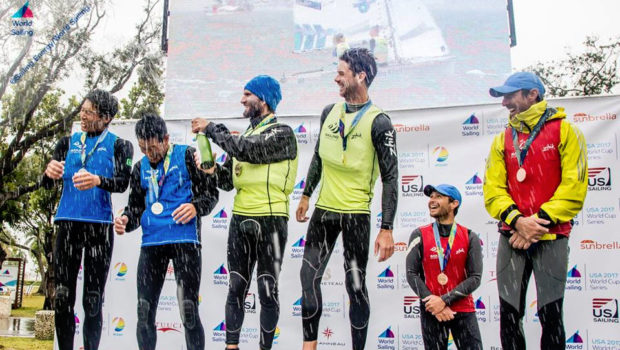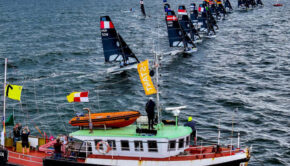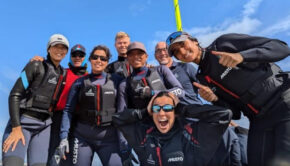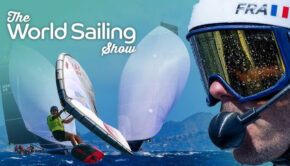World Cup Series On A Mission
Published on January 30th, 2017
by Craig Leweck, Scuttlebutt
For every Olympic event, whether it be Women’s Two Person Dinghy or the Heavyweight Men’s One Person Dinghy, there is a one design class association that is balancing the needs of all its class member… not just those seeking Olympic glory.
But for those on the Olympic track, a defined path of events is needed to gather these elite sailors and provide the structure and level of competition needed to prepare for the podium. That has been the mission of the World Cup Series.
The vision has been fine-tuned in 2017, with the overall goal is for the events to more closely match the actual Olympic Games experience. Changes that began at the World Cup Series Miami (Jan 24-29) is for all the events to maximize the opportunity they provide and seek to elevate all aspects of the events.
What is immediately notable is a reduced schedule of events. There were six events in 2016 but not all were well-synched with class schedules. Logistics and funding impacted participation. The re-set button was pushed in 2017, reducing the schedule to three events, which will better match the level of activity following an Olympic year. Four events are planned for the following years.
Additionally, the number of races at the World Cup events now matches what the sailors will experience at the Olympic Games. Depending on the class, this translates to either a 10- or 12-race Opening Series, thus helping prepare the sailors for that length of competition. While World Cup Series Miami did not have the laydays that is included in the Olympic schedule, the format in the Opening Series (entire fleet) and Medal Race (top ten) was otherwise the same.
The World Cup events now seek to match the Olympic level of competition too. In the past, the Opening Series at World Cup events might have huge fleets which required qualifying rounds. Now the World Cup includes entry quotas that more closely match the Games, and give the top ranked international sailors preference.
New for the sailors and spectators is the use of SAP Sailing Analytics, which is a tracking system developed specifically for the sport. While this allows for the online viewer to follow the races, the system also includes features for the sailors to better analyze the race and gather the reasons for why races were won and lost.
Additionally, the Sailing Analytics system ties into the live broadcast with 3D graphics that are an improvement over the previous system (Swiss Timing). The broadcast is increasingly becoming an area of emphasis, with the World Cup now providing a live online show for the Medal Races on Saturday and Sunday. Additionally, a one hour highlight show is delivered to a number of broadcasters around the world.
World Sailing, which oversees the World Cup events, brings along additional muscle to share event news. Leveraging the social media channels, in Miami there were two photographers, a photo editor, and a digital content producer doing some really cool stuff. The mission for World Sailing is to get closer to what would be done at the Olympic Games, and with all the time zones, this equates to nearly 24-hour coverage.
As the World Cup Series progresses, look for digital content to be at the heart of what is done from mobile apps. This includes assisting the sailors with all the information and notifications which occur during an event.
While progress is occurring with the new media tools, the World Cup remains committed to traditional print news as well. The Miami event had three writers pushing content, with one focused on the Spanish press. This proved particularly handy in Miami as Spanish is spoken by over 60% of the population, and worldwide is the second most spoken language (after Chinese and ahead of English).
In some respects, the World Cup events seek to go beyond what can occur at Olympic Games. The many media restrictions laid out by the International Olympic Committee at the Games effectively handcuff each sport’s federation in its ability to promote its events at the Games. But at the World Cup events, World Sailing is seeking to leverage all available innovations and technology.
Being mindful of the environment, World Sailing is also promoting a sustainability platform. The sailors in Miami were presented with water bottle when they registered, and filling stations were made available throughout the venue. There were even medal straws too. The hope is for the message – carry it in, carry it out – to resonate with the sailors, and for them to be leaders in their communities.
A big change in Miami was also the venue plan, which at one time was scattered about five or so sites around Biscayne Bay. However, in 2017 all activity was centered on Miami’s newest waterfront public space, the seven-acre Regatta Park in Coconut Grove. Only the boardsailers were at the adjacent Coconut Grove Sailing Club.
This has improved logistics not only for sailors and race administration, but also for the public too. The mission is to create an open atmosphere to expose sailing, with visitors able to freely experience the competition. For the Medal Races on Saturday and Sunday, a Jumbotron screen at Regatta Park hosted the live broadcast. Admission to the park was free and food trucks were on hand to ensure sailing fans don’t go hungry.
Overall, World Sailing is determined to make positive steps for the World Cup Series during this next quadrennium. This includes brining the World Cup events to the Olympic nation – another first. This will synch the event schedule with the sailor’s desire to train and acclimate, with the World Cup events offering the sailors with the consistency and quality they will experience at the Games.
Unlike most sports, where the role of the event venue is minimal, the sailors begin training at the Olympic venue much earlier. By bringing the World Cup to Japan, this gives the sport an early advantage. The opportunity to engage with the Japanese media two years out from Games time gives the sport a significant advantage. And in the realm of keeping the IOC happy, this is one shift that World Sailing is going to ride across the fleet.
Additional details: http://www.sailing.org/worldcup/home.php
2017 Sailing World Cup Series
SWC Miami (USA) – January 22-29, 2017
SWC Hyeres (FRA) – April 22-30, 2017
SWC Final Santander (POR) – June 4-11
Rio 2016 Olympic medallists automatically qualify for the 2017 Sailing World Cup Final and they will be joined by winners of the Sailing World Cup Miami and Hyeres Rounds. For the remaining places, qualification to the Final will be based on combined results at the Sailing World Cup Rounds, with the highest placed finishers booking their spot on the start line.
After the shortened 2017 series, the Sailing World Cup series will run from October to July every year, incorporating three Rounds and the Final at the end of June / early July.
As host of the Olympic Games, Japan will host a Sailing World Cup Round each October from 2017 through to 2019 before holding the Final in July 2020, just weeks before the Tokyo 2020 Games.
2017-18 Sailing World Cup Series
SWC Gamagori (JPN) – October 2017
SWC Miami (USA) – January 2018
SWC Hyeres – May 2018
SWC Final Kiel (GER) – June/July 2018
2018-19 Sailing World Cup Series
SWC Enoshima (JPN) – October 2018
SWC Miami (USA) – January 2019
SWC TBD (Europe) – May/June 2019
SWC Final Kiel – June/July 2018
2019-20 Sailing World Cup Series
SWC Enoshima (JPN) – October 2019
SWC Miami (USA) – January 2020
SWC TBD (Europe) – May/June 2020
SWC Final Enoshima (JPN) – July 2020









 We’ll keep your information safe.
We’ll keep your information safe.